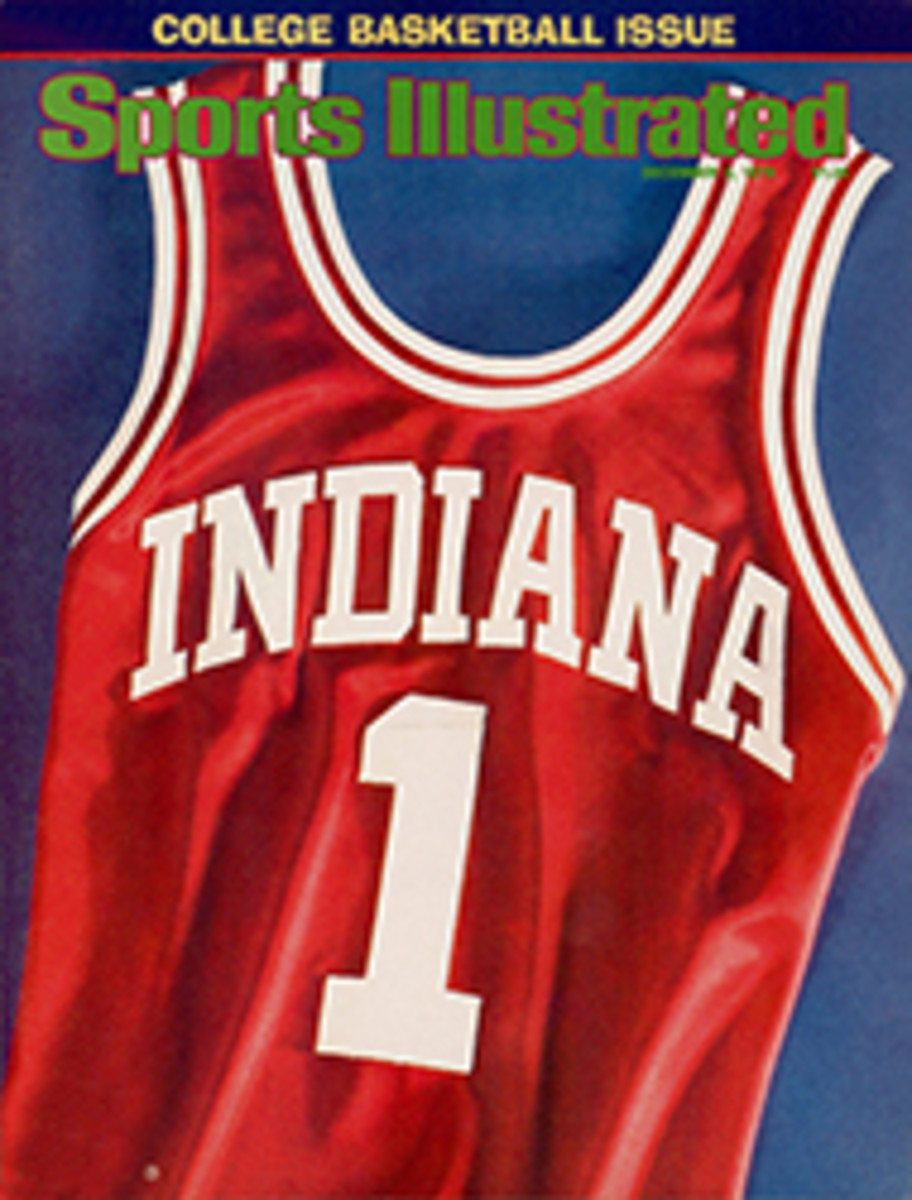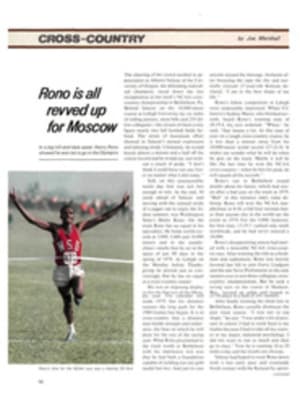
It was easy as pie
The Northfield Mount Hermon School is situated on the banks of the Connecticut River in western Massachusetts, deep in the heart of New England prep country. Its athletic rivalry with Deerfield Academy, a few miles to the south, is well known, at least in preppie circles, and Deerfield Weekend is the high, or low, point of Mount Hermon's football season, depending on its outcome.
For the last 88 years Mount Hermon has also been running, but its premier event, the annual Bemis-Forslund Pie Race, has been a rather well-kept secret. That's a shame, because there is nothing quite like it. For one thing, it is the oldest footrace in the U.S., six years older than the Boston Marathon and, by those who know it, more highly regarded. Students, faculty, staff, alumni and occasionally a guest or two are invited each year to the rural Mount Hermon campus to run a 4.5-mile cross-country course on the Monday of Thanksgiving week. The first three boy students, the first three girl students and the first alumnus and alumna to finish receive medals. Everyone else who beats a specified time—33 minutes for males, 40 minutes for females—gets a pie, a 10-inch, two-crust, all-American apple pie made that morning in the school bakery.
Successful middle-aged men have returned to Mount Hermon year after year in pursuit of that prize. When gasping runners cross the finish line, the urgent question on their lips is not "Who won?" or "What was my time?" but rather, "Did I win a pie?"
In the beginning, 1891, the race was not for pies and was distasteful to many because it was compulsory. Every student at the Mount Hermon School for Boys, "an earnestly Christian" institution founded by Dwight Lyman Moody, a celebrated evangelist of the day, was required to run a six-mile cross-country race once a year, regardless of his age or physical condition. The winner was given a medal, but everyone else ran for the greater glory of his dormitory team. Fifty-six years later, the Rev. Orvil (Pappy) Mirtz, Class of '25 and a retired faculty member, still remembers the experience as one of the worst of his life.
"Oh, it was just awful," says Axel B. Forslund, the man who changed all that. Forslund is a towering, genial Swede from Brooklyn who retired in 1970, after 41 years as Mount Hermon's athletic director, with his Flatbush accent intact. He had arrived at the school in 1929 at the age of 25, fresh out of Springfield College and with progressive ideas about physical education. By 1932 he had shortened the course to its present 4.5 miles, made participation voluntary, located an alumnus named Henry Bemis willing to endow a fund to pay for the medals and the pies and set the qualifying time for a pie at 33 minutes.
"Why pies?" said Forslund last week, back on campus to fire the starting gun, as he does each year. "Oh, it was something different, something to eat and something to share with roommates. Boys were always hungry."
At the beginning only 10 or 12% of the boys who ran won pies, but over the years the number has gradually risen until today, with 33 minutes still the criterion, about 80% of the field carries home a pie. This year, of the estimated 509 who finished, 420 won pies.
In 1972, when the student bodies of Mount Hermon and its sister school across the river, Northfield, were merged, girls began to compete, and what had been the Bemis Pie Race since 1931 became the Bemis-Forslund Pie Race to honor Gladys Forslund, Axel's wife, a loyal spectator at all Mount Hermon sporting events for four decades.
In a normal year the Pie Race is pretty much a family affair. This year, however, Mount Hermon is celebrating its centennial, and for the occasion, Frank Shorter, Class of '65, the school's most celebrated sporting alumnus, agreed to return for a try at regaining the race record he had held from 1965 to 1975. With Shorter in the field, a simple, down-home pie race became a media event and potentially a step on the road to Moscow, where Shorter is said to be aiming for the 10,000 in the Olympics.
The progress of Shorter's recovery from the foot surgery he underwent in April 1978 has been the subject of much speculation. He was disappointed with his seventh-place finish in the New York Marathon in October but was cheered the next day when an examination revealed a lower back condition and resultant nerve damage in his left leg that may have been the source of his leg and foot ailments all along. Most people would not breathe easier upon discovering they had back trouble, but Shorter's experiences over the past three years have been so puzzling and frustrating that he seemed delighted at last to have something tangible to come to grips with.
The significance of the humble Pie Race in the grander Olympic scheme of things was that if Shorter was going to try to break the record set by a student, Kevin Prest, in 1975 (21:54), he was going to have to run hard. Only Shorter knew whether he could, and he wasn't saying. Someone looking for clues, however, might have noted his remarkably high spirits when he arrived at the old school.
An aura of dignity bordering occasionally on hauteur surrounds Shorter at most public occasions. He does not suffer fools gladly. His brown eyes flash and his slender hawklike nose fairly quivers with a disdain that keeps even the dimmest wits at bay. Yet on this visit, his first to Mount Hermon since 1968 when he was a junior at Yale, he was at ease and apparently enjoying himself. He and his wife Louise and their 7-month-old baby, Alex, wandered the campus, took meals with the students in the cafeteria-style dining hall and talked with whoever approached them. At first the students held back, trying politely not to stare, but at the same time sizing Shorter up with furtive glances. Eventually they gave up and gawked. At lunch on the day of the race, a table was reserved for the cross-country teams and the Shorters to share. Frank talked about training as it was in his day ("We warmed up, ran five miles and showered"); asked questions about the prep school cross-country championships held a week earlier, in which the Northfield Mount Hermon girls' team had won; and cracked them up with a story of Row he had once brushed his teeth after lights-out with his acne medicine.
The traditional starting time for the Pie Race is 3:55 p.m., following the last class of the day. In late November that means a great many runners finish in darkness. This year, to accommodate television and still photographers, the last class of the day was canceled and the race was rescheduled to begin at 3:30. As the Mount Hermon Brass Ensemble played Walton's Fanfare and Mouret's Rondeau (better known now as the Masterpiece Theater music), the host of runners—406 of the student body of 1,130 had entered—lined up at the south end of a large playing field, shivering in the late afternoon chill.
With Axel Forslund's gun they were off, a mass of color streaming past a background of bare sugar maples and a gray stone chapel on a hill; past Crossley Hall, where Shorter recalled having warmed his pies on a radiator when he was a student; past the tennis courts and Shadow Lake, where the hockey team used to play before it got an indoor rink and its own Zamboni. On a winding drive leading downhill toward the school's main gate, about three-quarters of a mile into the race, Shorter took the lead. Out the gate they went, onto a two-lane highway for a few hundred yards, then off again onto Turners Falls Road, a dirt lane through school property, with barren winter woods on one side and fields of corn stubble on the other.
At the halfway point Shorter was flying and the pack was far behind. The runners made a left turn at Day's Corner, 2.7 miles out, around a pile of rusty farm machinery and onto North Cross Road, past a goat tethered in a side yard, past a colorless, weatherbeaten scarecrow and some beehives.
At 3½ miles the course turned left again and started up Overtoun Hill, a steep, quarter-mile pull, dotted with white frame faculty houses. Shorter said later, "I liked that hill." From the top of the hill, with its view of the river and rolling wooded hills to the horizon, it was down to the playing field, around its south end and through a corridor of cheering onlookers to the finish line at the flagpole. With his 20:54 clocking, Shorter had cut a full minute from Prest's record, and he was beaming. He posed for pictures with his pie, and he posed with the second-and third-place finishers and their pies. "Just like old times," he said. He signed autographs until the cold began to penetrate; and then he went into the gym and signed some more. "I really ran hard for the first time in a long time, and it felt good the whole way," he said.
The first time Shorter ran the Pie Race was in 1963, when he was a 16-year-old sophomore at Mount Hermon. He had never run in competition run before. Skiing, football and baseball were his sports that year, according to The Gateway, the school yearbook. He says he started that race in about 50th place and gradually worked his way up through the field until, at the finish, he was seventh. Ahead of him were the five-man cross-country team and one cross-country skier. "That was what got me interested in running," he says. "That and the fact I was getting my rear end kicked all over the place playing football."
It is accepted as gospel in running circles that the Great Running Boom in this country was born with Shorter's victory in the Olympic Marathon in Munich in 1972. Perhaps. But it appears that a good case could be made that it really began with a seventh place in a pie race on a November afternoon in Massachusetts in 1963.
PHOTO
The field streams by the Mount Hermon School's chapel at the start of the country's oldest footrace.
PHOTO
The top finishers: Shorter (left); John Greenplate, a faculty member; David Ehrenthal, Class of '79.

